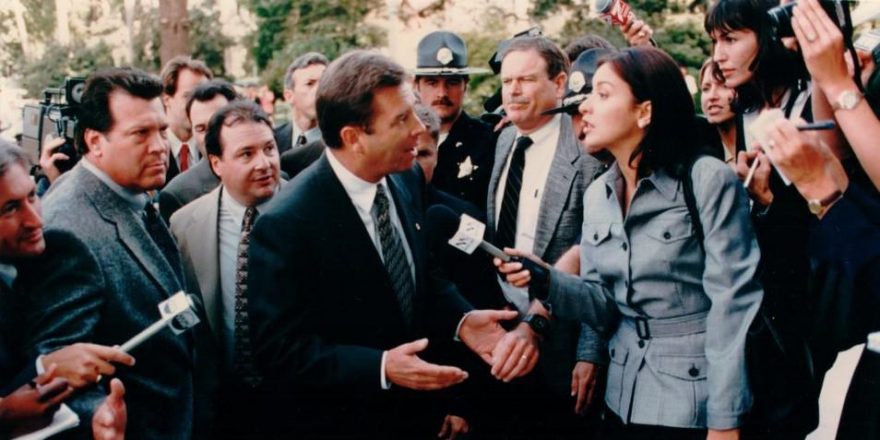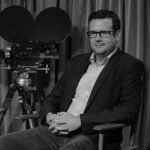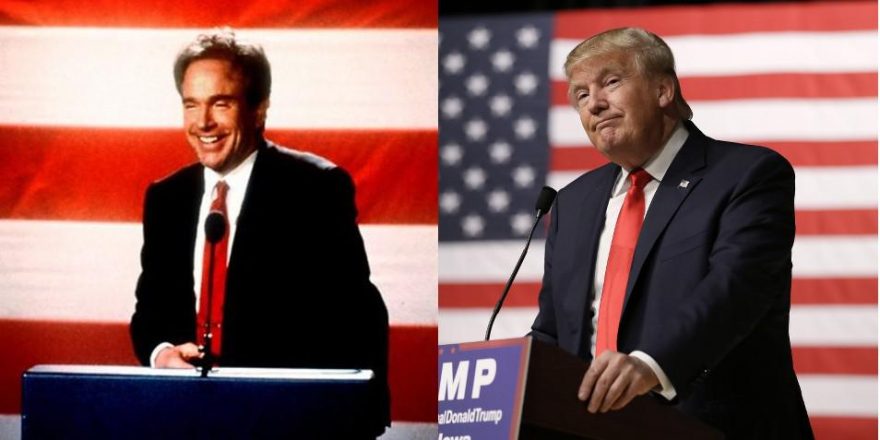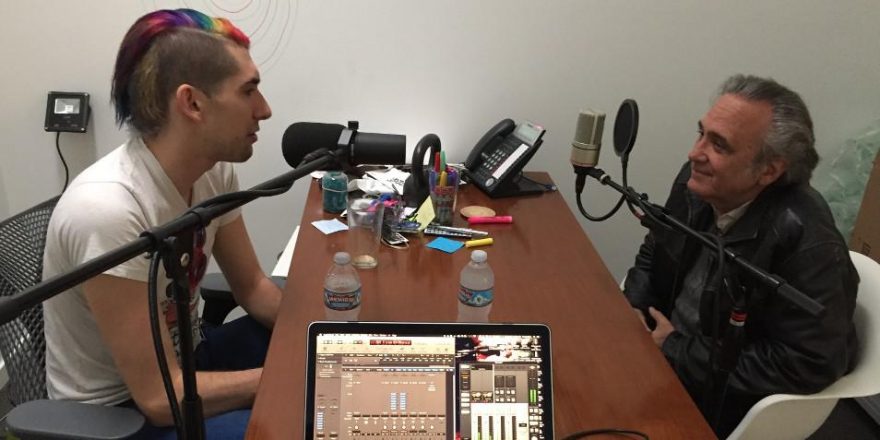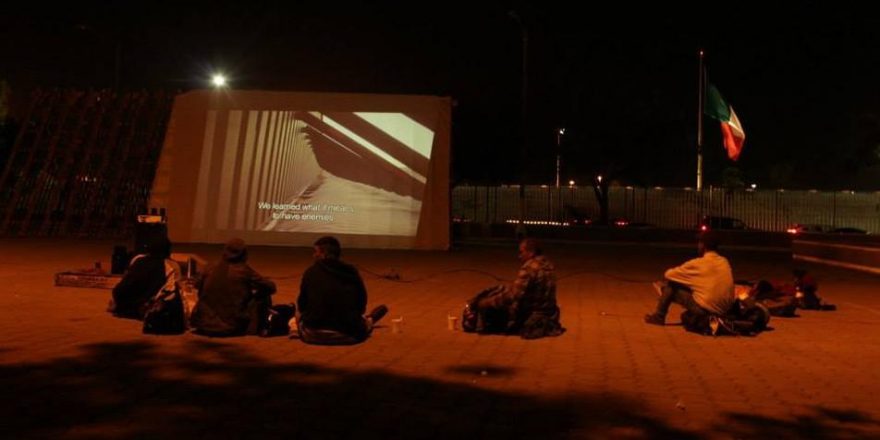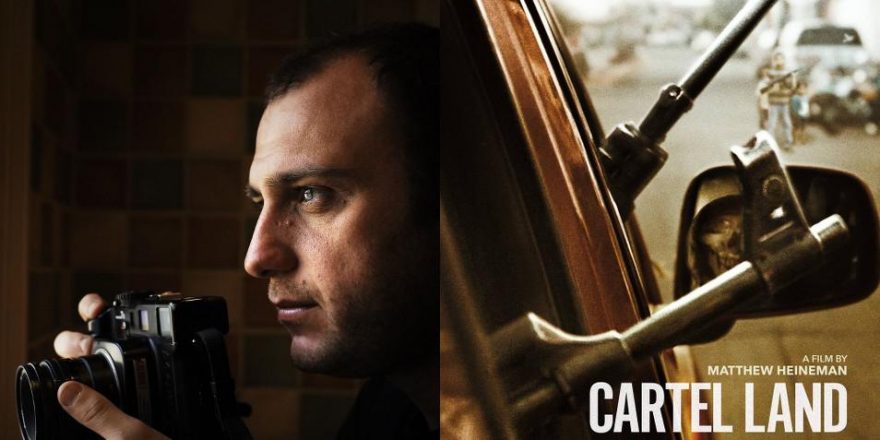Joe Dante’s 1997 made-for-HBO movie The Second Civil War opens with a title card reading, “Sometime in the near future,” which seemed a lot funnier 19 years ago than it did when I revisited the film last week. The 97 minutes that follow that title card are packed with provocative insights and unsettling observations, culminating in a climax that felt disturbing if slightly ridiculous in 1997 but comes across as distressingly plausible in the age of Trump and Cruz. I can’t think of another movie that unnerved me more, which is remarkable given that The Second Civil War is ostensibly a comedy, but then Dante has always been far more than a mere satirist or genre filmmaker (though he happens to be one of the best of each that we’ve ever had). In fact, his is one of the most expansive visions in the history of American cinema, encompassing humanism and cynicism in equal (and equally strong) measures, embodying Fitzgerald’s dictum that “The test of a first-rate intelligence is the ability to hold two opposed ideas in mind at the same time and still retain the ability to function.” He’s the American answer to Jean Renoir, and The Second Civil War is his masterpiece.
The film’s relevance to our current political climate will become obvious upon a brief description of the plot, which follows the events that unfold after the Governor of Idaho (Beau Bridges) announces he will not allow a planeload of Pakistani children orphaned by war into his state. He calls up the National Guard to keep the refugees from entering Idaho, sparking a national crisis as the President (Phil Hartman) orders his own troops to the border and neighboring red states send additional forces to aid Idaho against the federal government. While the President ponders what action (or inaction) will serve him best come election time – most significantly weighing how to avoid interrupting the airing of Susan Lucci’s last episode of All My Children when and if an armed standoff explodes into violence – the Governor is mostly distracted by his affair with a beautiful reporter (Elizabeth Peña), herself an immigrant. The reporter works for NewsNet, a CNN-style news network that both exploits and shapes the crisis, which ends in tragedy thanks to a combination of cynical calculations, well-intentioned mistakes, personal prejudices, and basic ineptitude and misunderstandings.
Throughout the film, Dante jumps back and forth between the focal points of the story: the Idaho border and Governor’s quarters, NewsNet in New York, and the White House. Within each of those settings are dozens of characters and intersecting relationships, all of which in one way or another affect the development of the impending conflict of the title. There are more than 50 speaking parts in the Altman-esque ensemble, all of which Dante juggles with expert precision and balance – there’s enough material here for four or five movies, but the director’s ability to place multiple perspectives and ideas within the same frame keeps The Second Civil War from ever feeling rushed or overstuffed, and every character and point of view gets its proper due. This is the key to Dante’s greatness, and what makes The Second Civil War such an indispensable film. It completely delivers the goods as a biting satire of Trump’s wall and Cruz’s patrolling of Muslim neighborhoods (almost two decades before these ideas actually entered the public consciousness, because Dante had his grip so firmly on the culture and where it was going), with hilarious moments like a campaign ad in which the Idaho governor promises “America…as it should be,” or a depressingly prescient but very funny scene in which he visits a family home proudly filled with guns and ammo. (“Turn left at the rocket launcher.”) Yet Dante isn’t content to settle for easy potshots – he starts where lesser filmmakers would end up, and goes on to build, character by character and image by image, a comprehensive portrait of America every bit as epic as Altman’s, and even more complex.
Dante builds a comprehensive portrait of America every bit as epic as Altman’s, and even more complex.The Governor Farley character played by Beau Bridges is a key example of Dante’s approach. While he’s established as a bit of a sloganeering buffoon, his developing relationship with the Mexican reporter adds layers of shading and nuance to his character. (Phil Hartman’s President is treated with less sympathy, but after eight years of Reagan, eight of W., and a possible Trump presidency, I’m not so sure that his dimwittedness is at all exaggerated or unjustified.) Farley’s honest passion for the woman has numerous effects on the audience’s impression of him, making him simultaneously more endearing (in his romantic nature) and more of a monster (in his hypocrisy and solipsism regarding the border situation). This sense of contradiction is at the heart of Dante’s work, as almost all of Dante’s movies are simultaneously celebrations and critiques. To my taste, his best films aside from The Second Civil War are the other two pictures in his “war trilogy,” Matinee and Small Soldiers, both of which analyze the intersection between our entertainment and our wars and how both intersect with our fears, both real and imagined.
In The Second Civil War, Dante plays his usual games with contradiction, self-reflexivity and ambivalence but does so without the safety net of genre – its power derives from the fact that there are no gremlins or aliens or werewolves to give the audience the escape hatch of dismissing the events as in any way unreal. Although there is a modestly heightened aspect to the situations and performances (again, it feels less heightened every day), for the most part Dante’s camera does everything it can to convey a sense of realism and immediacy. The director eschews close-ups in favor of elaborately choreographed long takes (both in duration and size of composition) that incorporate multiple lines of action and perspectives in the same frame. There’s enough Steadicam work to make Dressed to Kill look like an episode of Barney Miller, as Dante weaves in and out of action and locations with an energetic, anxious rhythm that subtly sets the audience on the edge. The moving camera and long takes, combined with Dante’s exquisite use of depth of field, serves the dramatic function of making the action seem more charged and authentic while also underlining the thematic thrust of Dante’s world view: that while characters can be right and wrong, no one point of view is privileged over another – as in Renoir, everyone has their reasons.
This democratic approach feels all the more valuable in today’s increasingly divisive climate, which itself feels like the full fruition of all that The Second Civil War foretold. In virtually every scene of the movie there are multiple planes of activity going back farther and farther in the frame, and the constant flurry of extras implies that for all that we’re seeing and hearing, there’s still so much that we don’t know. This is what sets Dante apart from lesser satirists, his ability to claim a strong sociopolitical position while also acknowledging all of that position’s alternatives – and acknowledging there may be alternatives of which he and we are not even aware. The fact that there are multiple points of view is his point of view, a rare gift in both American cinema and culture in general these days. It’s a deeply humane sensibility, yet The Second Civil War is not a sweet or easily digestible film; at its heart it’s about how crises expose and inflame our divisions, and it makes its case powerfully and convincingly – so much so that I’m not even sure I’d call it a comedy anymore. Watching it this last time, the laughs got stuck in my throat on the way out – and I suspect if things keep moving in the direction they have been, when I revisit The Second Civil War a few years from now I won’t be laughing at all.



